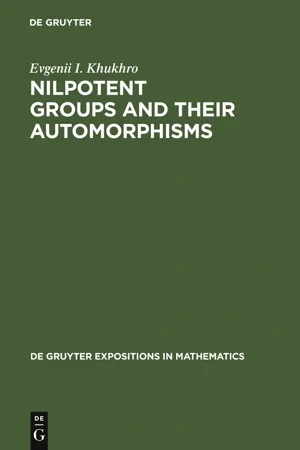
This is a test
- 266 pages
- English
- PDF
- Available on iOS & Android
eBook - PDF
Nilpotent Groups and their Automorphisms
Book details
Table of contents
Citations
Frequently asked questions
At the moment all of our mobile-responsive ePub books are available to download via the app. Most of our PDFs are also available to download and we're working on making the final remaining ones downloadable now. Learn more here.
Both plans give you full access to the library and all of Perlego’s features. The only differences are the price and subscription period: With the annual plan you’ll save around 30% compared to 12 months on the monthly plan.
We are an online textbook subscription service, where you can get access to an entire online library for less than the price of a single book per month. With over 1 million books across 1000+ topics, we’ve got you covered! Learn more here.
Look out for the read-aloud symbol on your next book to see if you can listen to it. The read-aloud tool reads text aloud for you, highlighting the text as it is being read. You can pause it, speed it up and slow it down. Learn more here.
Yes, you can access Nilpotent Groups and their Automorphisms by Evgenii I. Khukhro in PDF and/or ePUB format, as well as other popular books in Mathematics & Mathematics General. We have over one million books available in our catalogue for you to explore.
Information
Table of contents
- Notation
- Preface
- Part I Linear Methods
- Chapter 1. Preliminaries
- § 1.1 Groups
- § 1.2 Rings and modules
- § 1.3 Lie rings
- § 1.4 Mappings, homomorphisms, automorphisms
- § 1.5 Group actions on a set
- § 1.6 Fixed points of automorphisms
- § 1.7 The Jordan normal form of a linear transformation of finite order
- § 1.8 Varieties and free groups
- § 1.9 Groups with operators
- § 1.10 Higman’s Lemma
- Chapter 2. Nilpotent groups
- § 2.1 Commutators and commutator subgroups
- § 2.2 Definitions and basic properties of nilpotent groups
- § 2.3 Some sufficient conditions for soluble groups to be nilpotent
- § 2.4 The Schur-Baer Theorem and its converses
- § 2.5 Lower central series. Isolators
- § 2.6 Nilpotent groups without torsion
- § 2.7 Basic commutators and the collecting process
- § 2.8 Finite p-groups
- Chapter 3. Associated Lie rings
- § 3.1 Results on Lie rings analogous to theorems about groups
- § 3.2 Constructing a Lie ring from a group
- § 3.3 The Lie ring of a group of prime exponent
- § 3.4 The nilpotency of soluble Lie rings satisfying the Engel condition
- Part II Automorphisms
- Chapter 4. Lie rings admitting automorphisms with few fixed points
- § 4.1 Extending the ground ring
- § 4.2 Regular automorphisms of soluble Lie rings
- § 4.3 Regular automorphisms of Lie rings
- § 4.4 Almost regular automorphisms of prime order
- § 4.5 Comments
- Chapter 5. Nilpotent groups admitting automorphisms of prime order with few fixed points
- § 5.1 Regular automorphisms of prime order
- § 5.2 Nilpotent p-groups with automorphisms of order p
- § 5.3 Nilpotent groups with an almost regular automorphism of prime order
- § 5.4 Comments
- Chapter 6. Nilpotency in varieties of groups with operators
- § 6.1 Preliminary lemmas
- § 6.2 A nilpotency theorem
- § 6.3 A local nilpotency theorem
- § 6.4 Corollaries
- § 6.5 Comments
- Chapter 7. Splitting automorphisms of prime order and finite p-groups admitting a partition
- § 7.1 The connection between splitting automorphisms of prime order and finite p-groups admitting a partition
- § 7.2 The Restricted Burnside Problem for groups with a splitting automorphism of prime order
- § 7.3 The structure of finite p-groups admitting a partition and a positive solution of the Hughes problem
- § 7.4 Bounding the index of the Hughes subgroup
- § 7.5 Comments
- Chapter 8. Nilpotent p-groups admitting automorphisms of order pk with few fixed points
- § 8.1 An application of the Mal’cev correspondence
- § 8.2 Powerful p-groups
- § 8.3 A weak bound for the derived length
- § 8.4 A strong bound for the derived length of a subgroup of bounded index
- References
- Index of names
- Subject Index